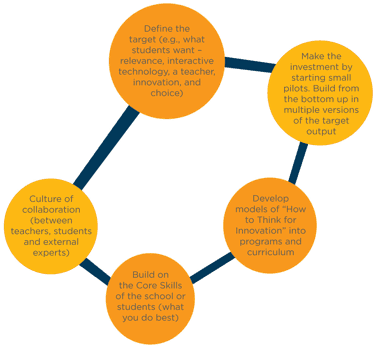Using the Principles of Innovation to Develop Technology
By Alan K. Rudi
Awareness and understanding of current technology’s capabilities is the foundation of innovating that technology into the future. The bits and bytes are mere details; the important thing is an awareness of any given technology’s possibilities. The key principles for innovation and technology development are:
- Be aware of technical developments that can directly impact an organization. In education, for example, the digital books of the future will be highly interactive.
- Understand where good ideas come from and how to get them. The answer: collaboration.
- Appreciate the role of failure in the innovation process. It’s just an often-necessary step toward success.
- Explore unrelated innovations to allow one idea to trigger another. Look at exciting innovations coming from industry in energy, transportation, computing and communications, Web and digital media, materials, and biomedicine. What’s the innovation and how can it apply to what I am doing?
- Think about the transformational technology changes developing now and how they may impact you – like the future of the Internet.
- Learn how successful innovators innovate. They expect innovation from their people, and they provide them with opportunities to innovate.
Develop Systematic Thinking for Innovation and Technology Development
There are four models of the types of thinking required for successful innovation and technology development. These types of thinking allow innovation to flourish throughout the implementation of any new technology initiative. To become true innovators, schools and students need to learn to:
- Convert data to knowledge.
- Understand the organizational drivers of innovation.
- Develop the leadership styles for innovation.
- Think in ways that result in innovation.
The skills required to create innovation include not just the ability to gather data and present information, but the ability to convert them into understanding. These skills are typically developed by defining projects in small teams (ideally, 3 to 7 people), including outside experts in the process (such as a teacher), learning and applying relevant technology tools (like simulation models for students to gain actual experience), asking the right questions throughout the process (for example, Toyota’s rule is to routinely ask “why?” five times per proposed solution while progressing with each technology development project) and simply spending time thinking about the meaning (such as a teacher encouraging students to present the knowledge they’ve gained from a particular project).

Most people rely heavily on information, gathering answers and facts and compiling reports and graphs—and then they stop. Successful leaders and innovators go much further. Once they reach a preliminary conclusion, they review their knowledge and push for wisdom by gaining additional experience or simply stepping back. Stopping to ask, “Am I getting to wisdom or just providing information?” propels them forward to push harder and focus on meaning. This is the way to get students to really think and learn, and it’s an ideal teachers should strive toward. Create lesson plans to take students from data to knowledge and inspire them to hone the skills and patience involved in becoming innovators.
Unfortunately, the heavy burden of mandates draws today’s schools’ focus toward the standardization of teaching and learning. Such a cookie-cutter approach snuffs out the flames of creativity, which requires the development of uniqueness in both teaching processes and students’ skill development. Organizational drivers of innovation and technology development must:
- Have a target in mind. In schools, the target is what the students say they want. One thing students desire is relevance, so teachers must ask, “How do I get there?” In business, the target is a target customer and what they want.
- Incorporate the successful models of how to think like an innovator. (See illustration: “Think About Thinking.”)
- Play to your strengths. It makes much more sense to build upon a foundation of what’s already working than to start behind the eight ball by needing to first overcome a weakness.
- When you decide to develop something new, invest some money in it. Starting small is fine and sometimes the best plan. Much can be accomplished by launching a strong idea with modest investment. Start small, learn, grow, develop and flourish. You don’t need to try to change the world all at once. Start small and lean, and soldier on.
Don’t assume that technology development depends on the IT department, one brilliant expert or a flash of genius. In reality, the best innovations happen when someone asks someone else a question, they work together, and bounce ideas off one another. Someone creates something that fails, and someone else says, “try this.” We need collaboration. Experience dictates that three to 7 people make a large enough group to include multiple perspectives, but is also small enough to avoid bureaucracy and an overly competitive environment.

Alan Rudi is the General Manager of Thesys International , an education business that supports schools with a hybrid online / classroom approach to education. As a Fairmont Education Group company, Thesys represents the culmination of thought, curricular innovation, and evolution of the classroom throughout Fairmont’s 57-year history as a leading educational provider in Southern California. At Thesys we believe in innovating with technology. We believe in kids, and in kids innovating. We believe a new educational model can inspire a new generation of learners. Follow Alan on Twitter at @ThesysIntl.





0 Comments
Leave a Comment
Your email address will not be published. All fields are required.